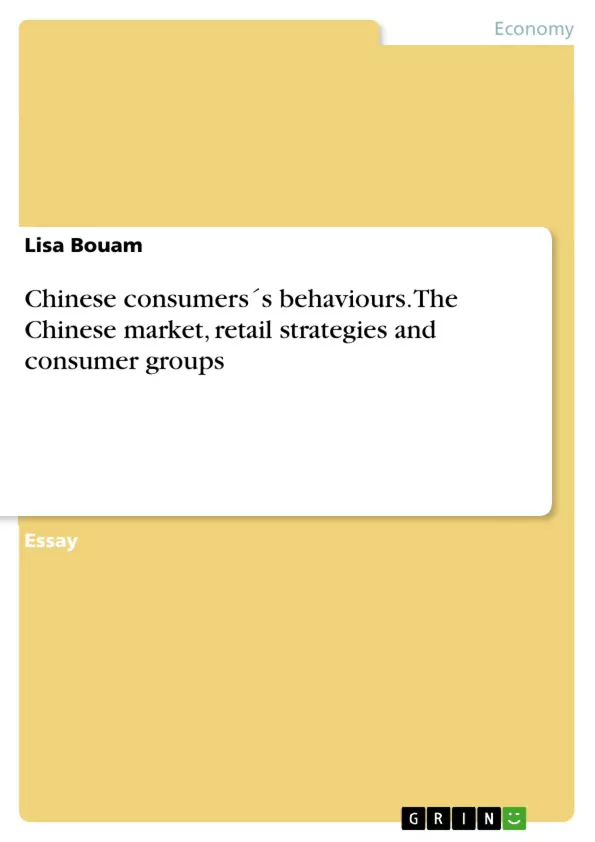China´s reform and open up policy initiated in 1978 has contributed to expanding its economy. From 1989 until 2013, China GDP Annual Growth Rate averaged 9.2%. While Europe and the US are facing a decrease of their inhabitant’s ´purchasing power, China´s growth has led to the apparition of a significant middle class which is getting richer and buys more than its elders. China represents a huge potential for multinationals companies that have been trying to break into this market. Thus, understanding Chinese consumer´s behaviours has become essential to the establishment of a successful marketing strategy.
However, China as a country is also very diverse. A simple look at the administrative organization of the mainland part divided into five levels (municipalities, provincial capitals, prefectures, counties and county cities) reveals a significant segmentation which is even broader as soon as you leave the cost to go through the lands. What retail markets and channels should companies choose in order to target those markets?
Besides, as China had to face significant economic and political changes over the past few years, Chinese consumers´ shopping habits have been evolving dramatically. As a result, categorizing Chinese consumers can be very challenging since several factors such as age, localisation (rural/town) or revenue influence greatly Chinese’s consumers habits. In this essay, we will choose to distinguish Chinese consumers revenue wise: affluent, mainstream/aspirants, value, poor according to the categories that have been mentioned in McKinsey Study “Meet the Chinese consumer of 2020”.
What will China consumers buy next?
First, we will analyze the global trends of an evolving Chinese market. Secondly, we will explain why companies‘retail strategies should adapt to regional differences within the country (City/Rural towns, Cost/Inside, Different provinces).Thirdly, we will try to understand better Chinese consumer’s mindset by categorizing relevant consumers groups. Also, we will focus on Chinese consumer´s specificities compared to their westernized counterparts in terms of brand loyalty and perception.
Inhaltsverzeichnis (Table of Contents)
- 1 Summary
- Introduction
- I/ Global trends of the Chinese Market.
- II/ Retail markets and regionalisation...
- III/ Different type of consumers
- Conclusion..........\nSources..
- 2 Introduction
- 3 I/ Global trends of the Chinese Market
- 4 II/ Retail markets and regionalisation
Zielsetzung und Themenschwerpunkte (Objectives and Key Themes)
This essay aims to analyze the evolving Chinese market and its impact on consumer behavior. It explores the key factors influencing Chinese consumers’ purchasing decisions, including global trends, regional differences, and consumer segmentation.
- The impact of China's economic growth and industrialization on consumer behavior
- The importance of understanding regional differences in retail markets and consumer preferences
- The segmentation of Chinese consumers based on income and spending patterns
- The role of demographics, social pressures, and cultural influences on consumer choices
- The evolving landscape of China's retail sector and the growth of online and mobile commerce
Zusammenfassung der Kapitel (Chapter Summaries)
The first chapter provides an overview of the global trends shaping the Chinese market. It highlights the rise of a new generation of consumers with increasing purchasing power, influenced by factors like education, gender roles, and social expectations. This chapter also discusses the growth of discretionary spending, the trend towards higher-quality goods, and the emergence of the senior market. The second chapter focuses on regional differences in China's retail markets. It explains the significance of tailoring retail strategies to various city tiers and urban/rural contexts, considering the diverse spending patterns and preferences across different regions.
Schlüsselwörter (Keywords)
Chinese consumer, market trends, retail strategy, regionalization, consumer segmentation, discretionary spending, middle class, urbanization, demographic changes, brand loyalty, shopping behavior, economic growth, globalization.
- Quote paper
- Lisa Bouam (Author), 2011, Chinese consumers´s behaviours. The Chinese market, retail strategies and consumer groups, Munich, GRIN Verlag, https://www.grin.com/document/274963



